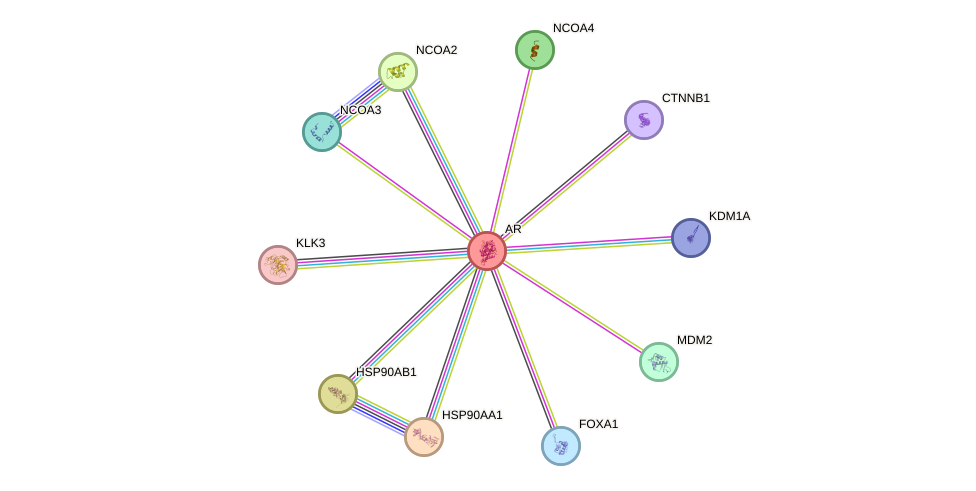GenAge entry for AR (Homo sapiens)
Gene name (HAGRID: 110)
- HGNC symbol
- AR
- Aliases
- AIS; NR3C4; SMAX1; HUMARA; DHTR; SBMA
- Common name
- androgen receptor
Potential relevance to the human ageing process
- Main reason for selection
- Entry selected based on evidence linking the gene product to the regulation or control of genes previously linked to ageing
- Description
AR is involved in transcriptional regulation and cellular proliferation and differentiation [576]. Disruption of AR in mice results in insulin (INS) and leptin (LEP) resistance, which suggests that AR may contribute to certain age-related diseases such as type 2 diabetes and cardiovascular disease [1331]. Its exact role in human ageing is unknown.
Cytogenetic information
- Cytogenetic band
- Xq12
- Location
- 67,544,032 bp to 67,730,619 bp
- Orientation
- Plus strand
Protein information
- Gene Ontology
-
Process: GO:0001701; in utero embryonic development
GO:0003073; regulation of systemic arterial blood pressure
GO:0003382; epithelial cell morphogenesis
GO:0006351; transcription, DNA-templated
GO:0006367; transcription initiation from RNA polymerase II promoter
GO:0006810; transport
GO:0007165; signal transduction
GO:0007267; cell-cell signaling
GO:0007283; spermatogenesis
GO:0007338; single fertilization
GO:0007548; sex differentiation
GO:0008283; cell proliferation
GO:0008284; positive regulation of cell proliferation
GO:0008285; negative regulation of cell proliferation
GO:0010628; positive regulation of gene expression
GO:0016049; cell growth
GO:0019102; male somatic sex determination
GO:0030521; androgen receptor signaling pathway
GO:0030522; intracellular receptor signaling pathway
GO:0030850; prostate gland development
GO:0033148; positive regulation of intracellular estrogen receptor signaling pathway
GO:0033327; Leydig cell differentiation
GO:0035264; multicellular organism growth
GO:0042327; positive regulation of phosphorylation
GO:0043410; positive regulation of MAPK cascade
GO:0043568; positive regulation of insulin-like growth factor receptor signaling pathway
GO:0045597; positive regulation of cell differentiation
GO:0045720; negative regulation of integrin biosynthetic process
GO:0045726; positive regulation of integrin biosynthetic process
GO:0045893; positive regulation of transcription, DNA-templated
GO:0045944; positive regulation of transcription from RNA polymerase II promoter
GO:0045945; positive regulation of transcription from RNA polymerase III promoter
GO:0048638; regulation of developmental growth
GO:0048645; animal organ formation
GO:0048808; male genitalia morphogenesis
GO:0050680; negative regulation of epithelial cell proliferation
GO:0050790; regulation of catalytic activity
GO:0051092; positive regulation of NF-kappaB transcription factor activity
GO:0051259; protein oligomerization
GO:0060520; activation of prostate induction by androgen receptor signaling pathway
GO:0060571; morphogenesis of an epithelial fold
GO:0060599; lateral sprouting involved in mammary gland duct morphogenesis
GO:0060736; prostate gland growth
GO:0060740; prostate gland epithelium morphogenesis
GO:0060742; epithelial cell differentiation involved in prostate gland development
GO:0060748; tertiary branching involved in mammary gland duct morphogenesis
GO:0060749; mammary gland alveolus development
GO:0060769; positive regulation of epithelial cell proliferation involved in prostate gland development
GO:0072520; seminiferous tubule development
GO:0090003; regulation of establishment of protein localization to plasma membrane
GO:2001237; negative regulation of extrinsic apoptotic signaling pathway
Cellular component: GO:0000790; nuclear chromatin
GO:0005634; nucleus
GO:0005654; nucleoplasm
GO:0005737; cytoplasm
GO:0005829; cytosol
GO:0005886; plasma membrane
GO:0043234; protein complex
Hide GO termsFunction: GO:0000978; RNA polymerase II core promoter proximal region sequence-specific DNA binding
GO:0001077; transcriptional activator activity, RNA polymerase II core promoter proximal region sequence-specific binding
GO:0001085; RNA polymerase II transcription factor binding
GO:0003677; DNA binding
GO:0003682; chromatin binding
GO:0003700; transcription factor activity, sequence-specific DNA binding
GO:0004879; RNA polymerase II transcription factor activity, ligand-activated sequence-specific DNA binding
GO:0004882; androgen receptor activity
GO:0005102; receptor binding
GO:0005496; steroid binding
GO:0005497; androgen binding
GO:0005515; protein binding
GO:0008013; beta-catenin binding
GO:0008134; transcription factor binding
GO:0008270; zinc ion binding
GO:0019899; enzyme binding
GO:0044212; transcription regulatory region DNA binding
GO:0046983; protein dimerization activity
GO:0051117; ATPase binding
GO:0070974; POU domain binding
Protein interactions and network
- Protein-protein interacting partners in GenAge
- TP53, ERCC2, STAT3, AKT1, EGFR, HDAC3, BRCA1, PTEN, CREBBP, NCOR1, HSP90AA1, UBE2I, EP300, GSK3B, ERCC3, PRKDC, AR, GTF2H2, XRCC5, XRCC6, RB1, FOXO1, SIRT1, HDAC1, HSPA1A, SP1, JUN, MED1, HMGB1, HMGB2, BMI1, TBP, SIN3A, E2F1, MDM2, TAF1, RELA, VCP, CEBPA, CEBPB, CTNNB1, PPP1CA, STUB1, NCOR2, GSK3A, CDK7
- STRING interaction network
Retrieve sequences for AR
Homologs in model organisms
In other databases
- CellAge
- This gene is present as AR

